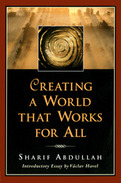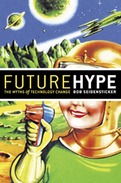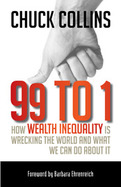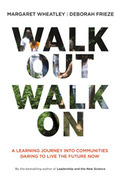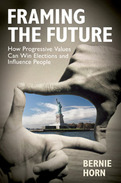But there is hope. Abdullah shows how we can change our world by changing our consciousness. We can actually put an end these complex problems if we reject exclusivity in favor of inclusivity. We must turn from a mentality that disconnects us and instead embrace the goals of restoring balance to the earth and building community with all other people. In Creating a World That Works for All, Abdullah provides a practical blueprint for that change.
Abdullah makes it clear that there are no bad guys to blame: we are all equally responsible for the current state of our world. We each have created it, and we each have equal power to change it. Abdullah offers three criteria for creating a world that works for all:
1. The Criteria of Enoughness: Everyone has enough, even though not everyone shares resources equally
2. The Criteria of Exchangeability: Trading places would be okay
3. The Criteria of Common Benefit: The system is designed and intended to benefit all
In order to meet these criteria, Abdullah shows us how to let go of old theories and ideas, so we can clearly see our current problems and possible solutions. And he shows us how to create new stories that explain and define the new behaviors that make cultural changes possible.
- Shows how we can create a world that works for all by rejecting the practice of exclusivity in favor of inclusivity
- Uses numerous insightful stories to illustrate how and why things don't work and how they can be made to work if we are willing to change our thinking and our society
2007
2006
But everyone is wrong. In fact, the pace of change isn't notably faster than in times past and most “revolutionary” technologies are just refinements of past breakthroughs. Using dozens of entertaining examples, high-tech industry veteran Bob Seidensticker debunks nine technology myths, proving that:
The rate of change is not exponential (myth #1),
Important new products don't arrive any faster than they ever have (myth #3),
The Internet doesn't really change everything (myth #8), and much more.
Future Hype exposes the hidden costs of technology and will help both consumers and businesses take a shrewder position when the next 'essential' innovation is trotted out.
- Convincingly debunks the myth that technology today is changing at an unprecedented rate and totally transforming modern society
- Gives readers the perspective to look skeptically at claims that every new technology is a world-changing breakthrough they must have
- Written by a twenty-five-year veteran of the high-tech industry who spent eight years as a Microsoft project manager
2012
Brings together facts and figures showing what "the 99% and the 1%" divide means in the real world and the damage it causes.
Identifies the social and historical forces that created and perpetuate this divide
Offers concrete proposals for closing the inequality gap
For over thirty years, we've lived through a radical redistribution of wealth-upward, to a tiny fraction of the population. It's as though we're undertaking a bizarre social experiment to see how much inequality a democratic society can tolderate.
As a result "We are the 99%," the rallying cry of the Occupy movement, has spread far beyond its ranks. But who are the 99 percent? Who are the 1 percent? How extensive and systematic is inequality throughout society? What are its true causes and consequences? How is inequality changing our world? And what can be done about it?
For many years, Chuck Collins has been a leading voice and activist on these questions. In this book he marshals wide-ranging data from a variery of sources to paint a graphic picture of how disparities in wealth and power play out in America and the world. For the first time, this book reveals the concrete meaning of "the 99% and the 1%," looking not just at individual households but at the business world, the media, and the earth as a whole.
Collins identifies the shifts in social values, political power, and economic policy that have led to our current era of extreme inequality -- particularly the way Wall Street has managed to rig the rules of the game in favor of the 1 percent-and surveys the havoc inequality has wreaked on virtually every aspect of society. But there is hope. Not only does he offer common-sense proposals for closing the inequality gap, but Collins provides a guide to many of the groups-including some made up of millionaires-that are working to bring about a society that works for everybody: for the 100 percent. This is a struggle that can be won. After all, the odd are 99 to 1 in our favor.
2011
2008
Polls consistently show that most Americans are progressives at heart. By margins of at least two to one, we favor affordable healthcare for all, even if it means raising taxes; want federal action to combat global warming; support stricter gun control; don’t want Roe vs. Wade overturned; and the list goes on. So why is it so hard for progressive candidates to win elections?
Because, says Bernie Horn, most progressives don’t know how to explain their ideas in ways that resonate with “persuadables”—the significant slice of the electorate who don’t instantly identify as Democrats or Republicans. These are the voters who swing elections. There’s been a lot of theoretical discussion about framing lately, but Framing the Future isn’t theory—the concepts outlined have been used successfully by progressive candidates across the nation, even in such conservative bastions as Montana, Arizona, and Florida.
Drawing on rigorous polling data and his own experience as a veteran political consultant, Horn explains how persuadable voters think about issues and make political decisions and why, as a result, the usual progressive approaches are practically designed to fail with them. He offers a crash course in the nuts and bolts of framing and shows how to use three bedrock American values—freedom, opportunity, and security—to frame progressive positions in a way that creates a consistent, unified political vision that will appeal to persuadable voters. He even offers advice on specific words and phrases to use when talking about a variety of issues and ideas.


